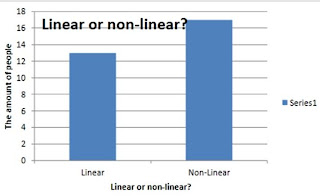How does your media product represent particular social groups?
What kind of media institutions might distribute your media product and why?
What have i learnt about technologies from the process of constructing this product?
Our target audience for our thriller was teenagers aged 15+. We set this target audience because the majority of our survey takers were also of that age. Plus, we are of that age right now. From personal experience we know what types of films most people our age would go and see, so we thought it would be the right thing to do. Here is a result from one question on our Audience Questionnaire:
 |
| Here we see the majority of our survey takers were of the same age. |
Our film classification was decided in the basis of our story and what we wanted to include in there. If our thriller was classified as a '12', we wouldn't have been able to include certain things as our content would be limited, therefore making it very difficult to create a thriller instead of an Action/Adventure type film. However, if we were to classify our film as an '18', it would be unnecessary as it limits our audience too much, 15-18 year olds are popular cinema-goers and they would have to miss out. Also the content would not be as graphic as it is in usual '18' films. After much consideration of classification, we decided our best option would to be to make the film to a '15' standard. Therefore our audience is not limited, nor are we tied down to how much content we have to limit. Nevertheless our production can and probably will attract audiences of a much older age due to the nature of the religious storyline, for example 50 years old. Sometimes older teenagers this day and age even go to see Disney films which would usually have a certificate of 'U'. The certificate doesn't stop people wanting to see the production, the story does.
Throughout the film making process we were constantly referring back to our audience feedback results to make sure we'd make the best decisions possible. On our questionnaire we asked various questions regarding thriller codes and conventions, we used our results as a guideline to giving the audience as much as they wanted.
 |
| Here the audience claimed that they enjoy a fast paced story-line better. Therefore we tried to not dwell on certain things for a long time and keep the pace of the film going most of the time. |
 |
| The audience has shown that they would prefer to see young people in our thriller, therefore we decided that we would have a teenage girl named 'Olivia' to fit with the audience's desires. |
 |
| Here we see that the fears enclosed spaces, the dark, spiders and being alone are quite equally feared among young people, so we decided to try and throw an element of each fear into our thriller. |
 |
| Here the audience shows that they prefer a non-linear storyline rather than a chronological storyline, therefore we incorporated a flashback into our opening. |
 |
| Here we know the audience' favourite type of thriller is Psychological, therefore we introduced the cellar, the enclosed space perhaps replicated a sort of prison. |
 |
| Here we decided to use the cellar, also because of its natural eerie feel. |
When our target audience watch our thriller we want them to feel saddened at the thought of the little girl being punished. Also, the fact that the film could be an insight into the violence which some children may go through when growing up, aswell as people that did have an unfortunate childhood like the girl in the story could sympathise. I want the audience to come away from the film thinking of what just might be going on behind closed doors. All seemed well at the start of the opening, until the camera entered the house. For audience feedback, see Audience Feedback - Post Viewing.
This video here is our preliminary task. The brief of the task was to create a short film, consisting of no longer than 2 minutes. Within the film someone had to enter a room, walk across the room, sit themselves across from a person, then they must engage in a short conversation with them using the '180' rule. Specific shots also had to be used like the 'Match-on-action' shot. The task was our first ever chance of using the cameras for ourselves. Filming this in college was quite difficult, especially if you wanted to get it perfect, this is because of the surroundings, there were other people doing the same as us so they also needed our space. There was also constant noise which we couldn't help, so we just had to get on with it. Editing our footage was much easier in my opinion, as we didn't have to deal with being rushed. The footage we had contained alot of continuity errors which couldn't be solved as we couldn't film anymore. From this task I have learnt how to edit footage on Adobe Premier Pro. Also I learnt how to avoid continuity errors better but I think this will come with more practice, naturally.
How did you attract/address your audience?


